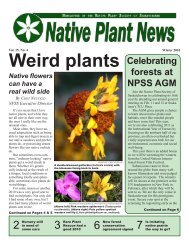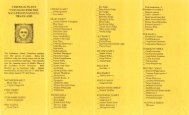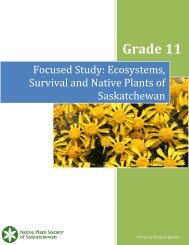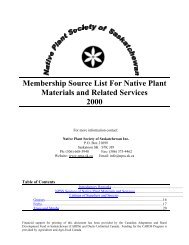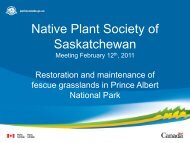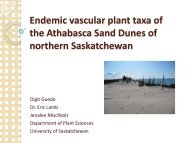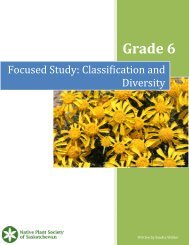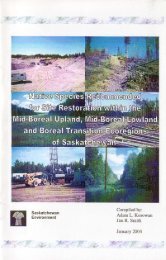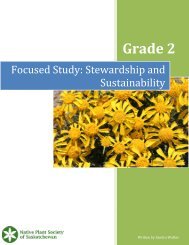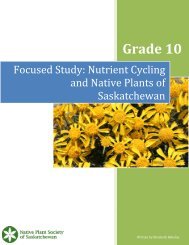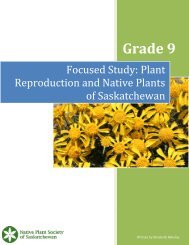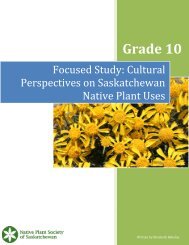Acreage Living - Native Plant Society of Saskatchewan
Acreage Living - Native Plant Society of Saskatchewan
Acreage Living - Native Plant Society of Saskatchewan
Create successful ePaper yourself
Turn your PDF publications into a flip-book with our unique Google optimized e-Paper software.
continuous grazirlg can be<br />
harmful to both native prairie<br />
and wildlife habitat. Observe how<br />
the native prairie looks on both<br />
sides <strong>of</strong> nearby fence lines, one<br />
overgrazed pasture and the other<br />
moderately grazed.<br />
Do the plants appear<br />
unhealthy (e.g., stunted,<br />
discoloured, spindly, wilted, or<br />
small)? If so, the roots have<br />
probably ceased growth and the<br />
land is less productive than it<br />
could be. Do steep slopes show<br />
signs <strong>of</strong> erosion? Are there areas<br />
<strong>of</strong> bare soil that could become<br />
colonized by weeds? It is fairly<br />
common on small farms and<br />
acreages to underestimate the<br />
feed needs <strong>of</strong> livestock while<br />
overesl.imating lhe productive<br />
capability <strong>of</strong> native prairie.<br />
To maintain healthy livestock<br />
and forage production, you will<br />
need to develop a sustainable year<br />
round feed supply plan. This<br />
involves calculating the amount<br />
<strong>of</strong> forage your animals will<br />
consume measured as Animal<br />
Unit Months (AUM's), the forage<br />
and hay production on your land<br />
and the feed (hay) requirements<br />
per animal. These calculations<br />
will indicate if your animals'<br />
needs can be met on your acreage<br />
alone. (See the resources section<br />
for range pr<strong>of</strong>essionals that will<br />
help you develop a grazing plan.)<br />
G0rd Erazing tanagement = G00d liuest0clt Hsalth<br />
lf your animals are:<br />
. Chewing on trees, shrubs, fences or barns;<br />
. Losing weight or are overweight;<br />
. Consuming dirt while trying to graze;<br />
. Sporting dull coats;<br />
Your grazing management system needs adjusting!<br />
Poor condition pastures and continuously grazing the same<br />
pastures may lead to increased parasite problems and overall<br />
poor health <strong>of</strong> your livestock.<br />
llid You l(nrw?<br />
<strong>Native</strong> grasses should not be grazed before at least three leaves<br />
have emerged in spring. Otherwise, there may be detrimental effects<br />
on both forage productivity and native prairie health. Most native<br />
grasses will have produced three leaves sometime after June 1. A<br />
good rule <strong>of</strong> thumb is, "for every day <strong>of</strong> early spring grazing you will<br />
lose two days later in the season". Thereforg try to hold <strong>of</strong>f on<br />
grazing until June.<br />
Horses do not need 24-hour access to food. Some horses may get<br />
too fat this can cause health problems. The daily nutritional needs <strong>of</strong><br />
an idle, mature horse can be met with as little as three to four hours<br />
<strong>of</strong> grazingon good pasture. Animals can be corralled for the rest <strong>of</strong><br />
the day to prevent overgrazing and to help extend the feed supply<br />
within pastures. This also helps save money on purchased feeds.<br />
Horses are'spot grazers". They tend to repeatedly overgraze certain<br />
areas and leave other areas untouched. Pasture rotations with other<br />
types <strong>of</strong> livestock (such as cattle) or regular mowing and scattering<br />
<strong>of</strong> horse manure may make grazing by horses more efficient over a<br />
wider area.



